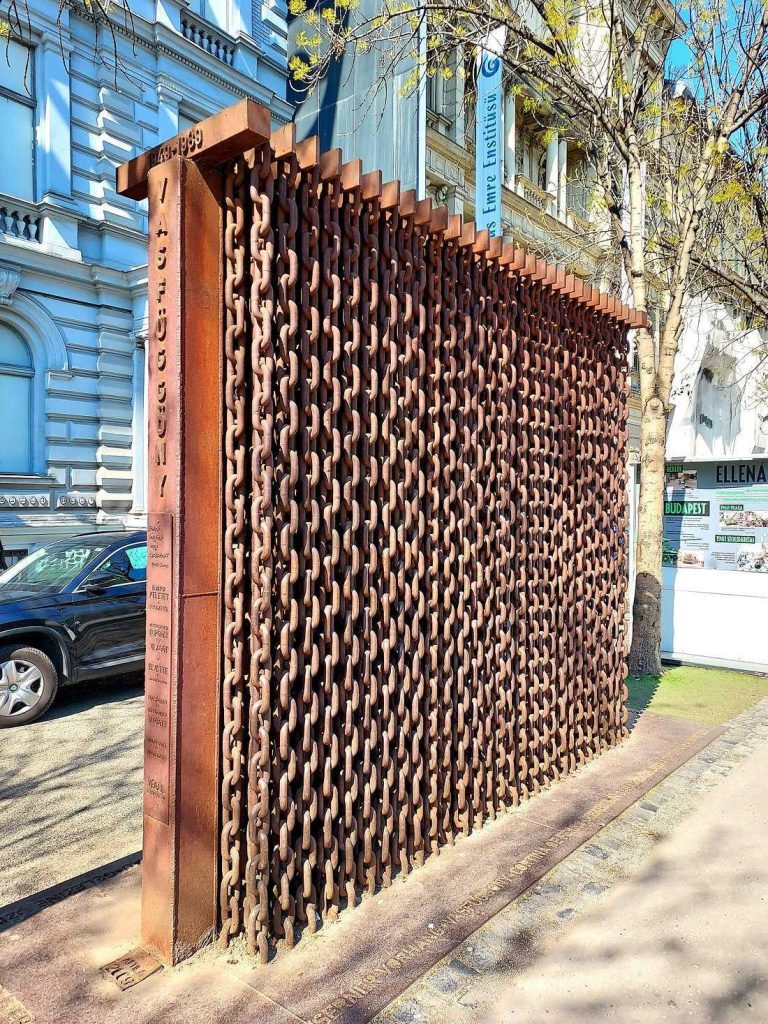Iron Curtain Monument: A Symbol of Divided History
Introduction
Delve into the past at the Iron Curtain Monument, a poignant reminder of Europe’s divided history and the Cold War era. Nestled in Budapest, this monument is a solemn tribute to the barriers that once separated nations and ideologies. The Iron Curtain Monument isn’t just a monument; it’s a window into a bygone era and a lesson in the pursuit of unity.
Historical Context
The Iron Curtain and the Cold War
Winston Churchill popularized the term “Iron Curtain” in 1946 to describe the division between the Soviet-controlled Eastern Bloc and Western countries during the Cold War. This ideological and physical divide spanned from the Baltic Sea in the north to the Adriatic Sea in the south, symbolizing the separation between communist and capitalist nations. The Iron Curtain represented geopolitical tensions and the human cost of separation, suppression, and the struggle for freedom.
Hungary and the Iron Curtain
As part of the Eastern Bloc, Hungary was directly impacted by the Iron Curtain. The country experienced significant political and social changes during the Cold War, including the 1956 Hungarian Revolution, a national uprising against Soviet-imposed policies. The erection and eventual dismantling of the Iron Curtain in Hungary are pivotal moments in the country’s history, reflecting the broader struggle and eventual collapse of Soviet control in Eastern Europe.
The Iron Curtain Monument
Design and Structure
The Iron Curtain Monument in Budapest is a stark and evocative structure designed to symbolize the physical and ideological barriers of the Cold War. The monument’s design typically features metal bars or fencing, reminiscent of the barriers stretching across Europe. These elements are often interspersed with symbolic breaks or openings, representing the eventual fall of the Iron Curtain and the triumph of unity and freedom.
Location and Significance
Situated in a significant location within Budapest, the monument serves as a focal point for reflection and education. Its placement in the city underscores Hungary’s historical role in the Cold War and its journey towards political and social transformation. The monument invites visitors to contemplate the impact of the Iron Curtain on Hungary and the broader European context.
Reflecting on Divided History
The Human Cost
The Iron Curtain Monument is a testament to the resilience and courage of individuals who lived through the Cold War era. Many families were separated, lives were disrupted, and freedoms were curtailed. The monument serves as a reminder of the human cost of political division and the enduring spirit of those who sought to overcome it.
Lessons in Unity
Beyond its historical significance, the monument offers lessons in the pursuit of unity and the importance of overcoming divisions. It highlights the necessity of dialogue, understanding, and cooperation in building a more unified and peaceful world. The Iron Curtain Monument encourages visitors to reflect on past divisions and consider their implications for contemporary global politics.
Visitor Experience
Educational Insights
The Iron Curtain Monument provides an educational experience for visitors, offering insights into the Cold War era and its impact on Europe and the world. Informational plaques and guided tours can enhance understanding, providing historical context and personal stories that bring the period to life. These educational elements ensure that the monument serves not only as a memorial but also as a valuable resource for learning.
Personal Reflection
Visitors are invited to engage in personal reflection at the monument. The solemn and contemplative atmosphere encourages individuals to consider the broader implications of division and unity in their lives and communities. Whether through quiet contemplation or thoughtful discussion, the monument provides a space for meaningful reflection on historical and contemporary issues.
Events and Commemorations
Throughout the year, the Iron Curtain Monument may host events and commemorations that honor significant anniversaries and milestones related to the Cold War and the fall of the Iron Curtain. These events offer public engagement, remembrance, and education opportunities, fostering a deeper connection to the monument’s themes.
Practical Information
Location and Accessibility
The Iron Curtain Monument is located in Budapest and is easily accessible by public transportation and car. Its central location makes it a convenient destination for both locals and tourists. Detailed directions and information about nearby amenities can be found on local tourism websites and guides.
Visiting Hours
The monument is typically open to the public year-round, with no admission fee. However, checking for any specific visiting hours or scheduled events that might affect access is advisable. Special commemorative events may also provide additional opportunities for guided tours and educational programs.
Nearby Attractions
Budapest offers a rich tapestry of historical and cultural attractions. The Iron Curtain Monument visitors can also explore nearby sites such as the Hungarian Parliament Building, the House of Terror Museum, and the Buda Castle. These attractions provide further insights into Hungary’s history and cultural heritage.
Conclusion
The Iron Curtain Monument in Budapest symbolizes divided history and the enduring pursuit of unity. Whether you’re drawn to history, interested in global politics, or simply seeking to understand the impact of past divisions, this monument promises an immersive experience that fosters reflection and offers insights into the complex narratives of our world. By commemorating the struggles and triumphs of the Cold War era, the Iron Curtain Monument stands as a testament to resilience, freedom, and the ongoing journey towards a more united world.

